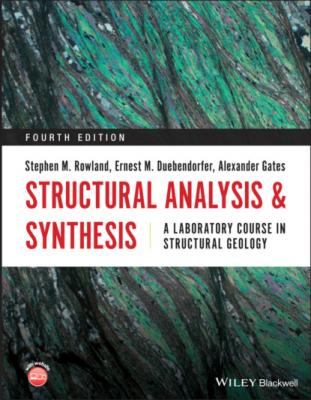ТОП просматриваемых книг сайта:
Structural Analysis and Synthesis. Stephen M. Rowland
Читать онлайн.Название Structural Analysis and Synthesis
Год выпуска 0
isbn 9781119535485
Автор произведения Stephen M. Rowland
Жанр География
Издательство John Wiley & Sons Limited
Structural Elements
The structural elements observed in an outcrop must be carefully discerned as actual components of the rock before they are measured. Many students attempt to take measurements from the surface of outcrops which generally are not suitable data. In most cases, it is better to extend the observed feature away from the outcrop surface with a book for planar features or a wooden pencil for linear features. This smooths uneven surfaces and eliminates the influence of magnetite or other magnetic minerals on the magnetic compass needle. Care must be taken that the tools used to extend the elements are not themselves magnetic.
Planar and linear elements have standard notations for use on geologic maps (Table 1.1). Planar elements include primary features such as bedding and dikes, as well as secondary features such as foliations including cleavages, faults, and joints. By convention, bedding is designated So as the most basic of surfaces. The foliations that overprint bedding are labeled S1–Sn, with S1 the earliest tectonic cleavage (typically slaty), followed by successive overprinting crenulation cleavages S2–Sn. In metamorphic rocks, foliations such as schistosity and gneissosity cannot be related to bedding so cannot follow the S1–Sn system. Instead, the oldest recognizable surface can be designated Sx and subsequent foliations designated Sx + 1 and so on.
There are primary planar features that can be used to reconstruct areas and document strain but don’t have S surface designations. For example, foresets in cross bedding can be used to determine flow directions and strain in some cases. They should be measured and documented.
Structural or secondary linear elements can be divided into two types, intersection lineations and stretching lineations. The intersection of any two planar surfaces produces a lineation. These can range from discrete features like pencil cleavages to more subtle features like wrinkles on foliation surfaces. It is best to measure the two planar features that create the lineation in most cases. These lineations can be designated by the two intersecting surfaces such as L1 × 2 (S2 crossing S1) for reference. Stretching lineations are of more common interest. They can be slickensides on faults or any linear fabric in an L or LS tectonite. In particular, lineations in shear zones are important because they can show movement sense, like slickensides. If needed, these can also be labeled by generation such as L1. Fold axes/hinge lines are measured as lineations (intersection).
There are also primary linear features that should be documented for reconstruction of a field area. In sedimentary rocks, parting lineations, flute casts, and groove casts among others can be documented and measured to help determine flow direction and strain in some cases. Plutonic and volcanic rocks can contain flow foliations that are also useful.
Table 1.1 Common symbols used on geologic maps.
|
|
Symbols for Common Structural Elements
Plotting or reading back any structural element requires determining the declination angles. This can be done digitally using a number of computer drafting programs. However, for this chapter, the exercise will be done by hand for better understanding. The procedure requires first to determine the reference direction (usually north) on the map in question. Next, a protractor is used to measure the angle between the reference direction and the strike or trend line to be measured or drawn (Figure 1.5). Students may need to watch online videos on the use of a protractor if they cannot remember how to use one. Finally, the proper symbol is chosen for drawing or determined for reading back and the angle of dip or plunge is written or read. Dip direction is shown by the tick mark on the side of the strike line and the dip is written next to it. The plunge angle is written on the plunging end of the trend line. Symbols for elements are shown in Table 1.1.
Figure 1.5 Measuring the strike or trend of a structural symbol using a protractor.
Structural Grain
In many areas, the structural geology controls the formation of the landscape. The alignment of ridges and valleys across an area can be controlled by the structural alignment of the bedrock. Such alignment is called structural grain. Structural grain is measured as a declination or bearing the same way as a strike or trend. A line can be drawn along or parallel to the general alignment of a ridge, expressed by the contours on a topographic map, as structural trend. The lines of structural grain are measured using a protractor, like strike or trend (Figure 1.6). Ridges are formed by more resistant units like quartzite, whereas valleys are more commonly underlain by less‐resistant rock such as shale. There can be several structural grains across a map depending upon the structural complexity of the bedrock in the area. By determining their orientations, the geology of an area may be more easily interpreted. Geologists use structural grain as a standard method to generalize the strike of units in geological interpretation.
Faults can also be recognized by topographic features. Faults are typically linear features on maps that can offset other topographic features such as ridges and valleys. They can also appear as profound breaks in topographic styles, juxtaposing hilly areas with flat areas. Active faults can offset rivers and other modern features. These fault lines are measured the same way as the structural grain with a protractor.
Plot the following structural elements on the map in Figure P1.1. Use the proper symbol (see Table 1.1) and label each (a, b, c, etc.).
1 N21°E, 57SE bedding
2 288°, 13 N joints
3 N26°W, 42SW cleavage
4 055°, 41SE foliation
5 017°, 68NW cleavage
6 233°/12° fold axis
7 270°/81°

